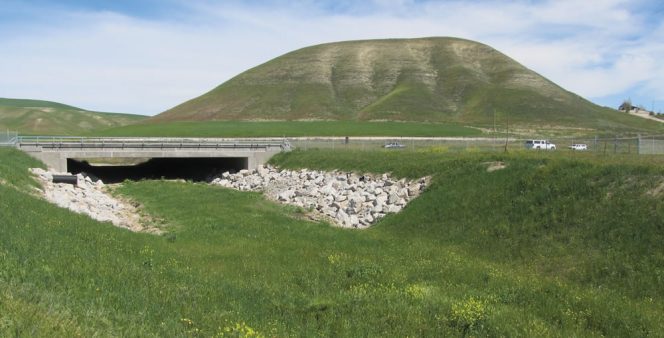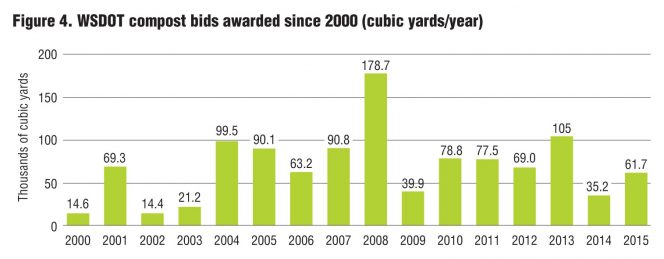Research project collects and analyzes compost use data for three state Departments of Transportation: California, Texas and Washington.
Ryan Batjiaka
BioCycle October 2016
Use of compost by state Departments of Transportation (DOTs) for highway construction, erosion and pollution control, and vegetation establishment has dramatically increased since the early 2000s. A recent research project studied compost use by state DOTs in Texas (TxDOT), Washington (WSDOT) and California (Caltrans). Of the three, TxDOT is the largest user of compost on an annual basis (and, according to TxDOT, the largest single market for compost in the U.S.).
WSDOT usage has remained relatively steady in the 2010s after several years of heightened use when compost first became widely adopted in the mid 2000s. The widespread adoption of compost at Caltrans occurred more recently in 2009 and 2010. Controlling for state population in each year, WSDOT (serving 7.2 million in 2015) and TxDOT (serving 27.5 million in 2015) have similar rates of compost use (Figure 1). Caltrans (serving 39.1 million in 2015) had much lower rates of compost usage per resident.
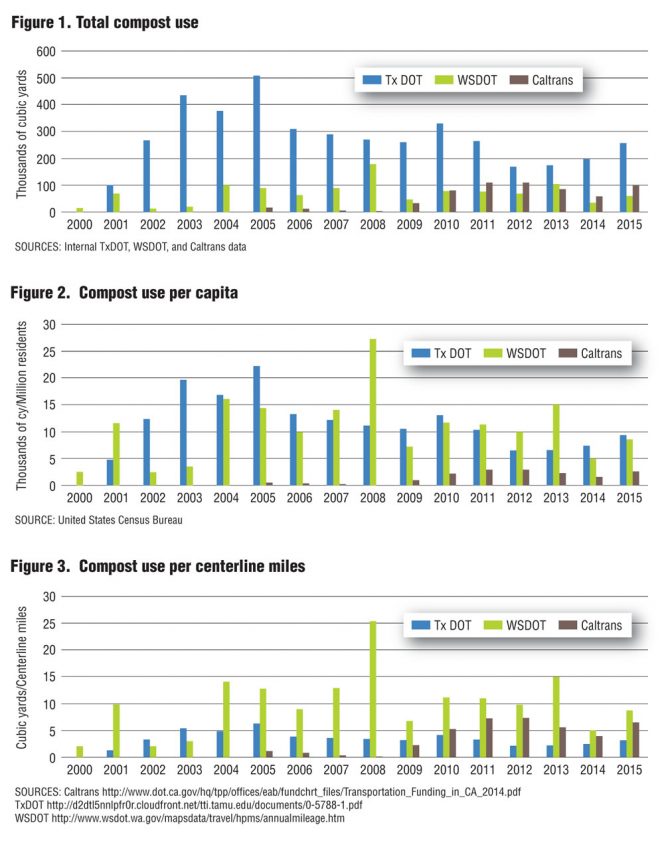
Figure 1. Total compost use
Figure 2. Compost use per capita
Figure 3. Compost use per centerline miles
The amount of roadway that a DOT maintains is calculated as either centerline miles, the distance of roadway maintained, or lane miles, the distance of roadway maintained multiplied by the lanes of that roadway. While lane miles are an important statistic when considering pavement maintenance, centerline miles are the pertinent measurement for the purpose of roadside compost use.
When accounting for the actual amount of roadway each agency maintains, WSDOT uses more compost — in terms of cubic yards/mile maintained — than the other two agencies (Figure 2), even though it maintained the lowest number of centerline miles at 7,056 miles in 2015. Caltrans maintains about twice this much, 15,100 miles in 2014. Although TxDOT uses much more compost in total than either WSDOT or Caltrans, it is also responsible for a vastly larger amount of roadway, 80,423 miles in 2014.
Caltrans has very little right of way acreage that it manages — 29,183 acres compared to WSDOT with 97,500 acres and TxDOT with a staggering 1.1 million acres. The large amount of right of way land that TxDOT manages increases the opportunities and needs for compost use; its primary applications are for vegetation establishment and erosion control. Compost use per dollar of agency expenditure (Figure 3) is higher at TxDOT and WSDOT than Caltrans. This is possibly due to Caltrans having less right of way acreage to maintain relative to other responsibilities.
Spotlight On Washington State DOT
The Washington State Department of Transportation is the largest purchaser of compost in the state of Washington. WSDOT’s compost use increased noticeably in the mid 2000s — from 14,584 cubic yards (cy) in 2000, to an average annual compost use of 92,690 cy from 2004 to 2010.
Many factors influenced adoption of compost as a standard design feature on WSDOT projects. In 1991, for example, the Washington State legislature enacted a law aimed at increasing the amount of recycled materials used by state agencies. Part of this statute required agencies to ensure that by 1998, 80 percent of funds used for soil amendment would be spent on compost. Although this mandate encouraged compost use, WSDOT had to identify new applications for compost before its usage could increase.
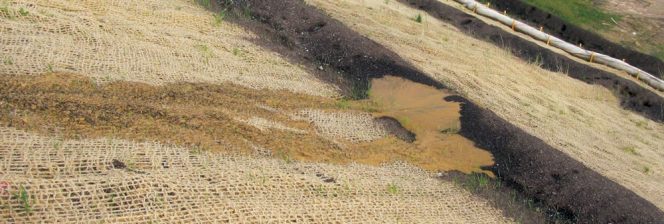
WSDOT Standard Specifications include application of compost blankets and installation of compost berms (seen here).
In 1999-2000, WSDOT undertook three bioengineering research projects in Lake Chelan, Lost Creek and Raymond. The goal was to stabilize slopes at the three sites with compost and vegetation establishment. The final report on the projects, “Soil Bioengineering for Upland Slope Stabilization,” showed that compost successfully stabilized the slopes, improved plant establishment and was more cost-effective than alternatives. In the 2001 Stormwater Management Manual for Western Washington, the Washington Department of Ecology approved the compost uses WSDOT had tested at Lake Chelan and elsewhere. This was an important step that made compost an officially accepted tool WSDOT could use for its projects.
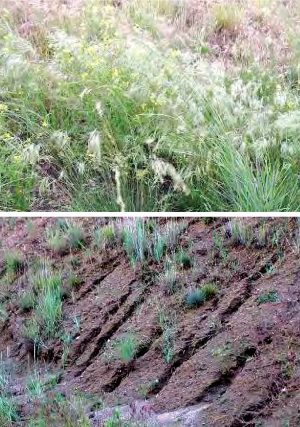
Highway slope stabilization research in Washington State evaluated compost’s performance for erosion control and vegetation establishment (with compost (top) and no compost (below).
WSDOT Acceptance Of Compost Use
As other WSDOT designers were shown the success of the three bioengineering research projects, compost began to be viewed as an effective tool for erosion control and plant establishment. There was some initial resistance to compost due to it being relatively expensive, fears that compost would blow away in windy locations in Eastern Washington, and a perception that compost was “dirty” compared to conventional products like straw or hydroseed mixes. However, as compost was used on more projects, each time with successful results, its effectiveness became clear within WSDOT. The acceptance of compost use would be reflected in updates to agency publications, namely the Standard Specifications and the Highway Runoff Manual.
Standard Specifications communicate basic expectations for work performed by WSDOT contractors. If a certain task is not detailed in the Standard Specification, the project designer can still put this task into the project plans. However, when a task is clearly defined in the specification, there are a number of benefits: Use of this practice is more official, the task is easier to insert into project plans and suppliers and contractors have standardized requirements they know will be relatively similar from project to project.
When practices are used by WSDOT and shown to work they are inserted into the Standard Specification. The 2002 WSDOT Standard Specification had only 5 mentions of compost. These mentions defined what compost was and explained that it could be used as a soil amendment. By 2004, the standard specifications contained 73 mentions of compost. The update included better quality control standards and new uses for compost such as compost blankets, socks and berms, and an explanation of how to use compost as a soil amendment.
The Highway Runoff Manual provides standards that WSDOT designers should use to plan appropriate storm water controls. While the 1995 edition did not mention compost once, the 2004 update mentions compost 165 times. Numerous compost uses are detailed in the manual, including compost amended vegetated filter strips, compost socks, amended dispersion areas, infiltration ponds and others. Other manuals would also be updated to include standards on compost, however the Highway Runoff Manual was the most important in codifying compost use at WSDOT.
Figure 4 shows actual quantities of compost used by WSDOT from 2000 to 2015. Compost use by the agency that is not specified in a contract is negligible. All compost applied is at new project sites and reapplication rarely happens. WSDOT generally has a single chance to establish self-sustaining vegetation on projects due to funding, which is why compost has become so important.
Over time, how compost is used on projects has been refined. Initially compost use was specified in project plans simply as compost or soil amendment. By 2015, 11 different uses for compost appeared in project plans. Compost is still considered a costly item on projects, so designers try to be as effective as possible when using it. For example, sites are now tested for organic matter, enabling WSDOT to specify only the quantity of compost required to raise soil organic matter up to target levels.
Although procuring large enough quantities for projects was sometimes difficult in the early 2000s in eastern Washington, the main problem WSDOT faced was quality control. When food waste became more common as a feedstock, contamination increased. WSDOT spent years adjusting the compost requirements with suppliers so that the material met WSDOT needs but was also something that could be produced. In 2006, the agency incorporated the US Composting Council’s Seal of Testing Assurance (STA) standards into its compost quality control protocol.
WSDOT’s compost use would not have increased as it did without the intervention of other institutions. The Department of Ecology, the Washington Organic Recycling Council, the University of Washington, Washington State University, and compost producers all facilitated WSDOT’s adoption of compost into their project designs. Within WSDOT, there also were staff who were receptive to compost use and could start initial test projects and then educate the rest of the agency. The partnership between these WSDOT personnel and outside institutions created the initial research studies and successful pilot projects that would convince WSDOT that compost could perform valuable roles in its projects.
Ryan Batjiaka is a soil science graduate student at the University of Washington.



